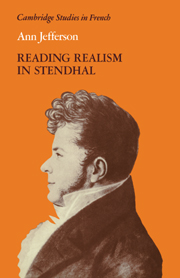Book contents
- Frontmatter
- Contents
- Preface
- PART ONE Introduction
- PART TWO De l'Amour
- PART THREE Le Rouge et le Noir
- 3 Unexpressing the expressible
- 4 The speaking of the quoted word: authors, ironies and epigraphs
- 5 The uses of reading
- PART FOUR Vie de Henry Brulard
- PART FIVE La Chartreuse de Parme
- Conclusion
- Notes
- Bibliography
- Index
- Cambridge Studies in French
5 - The uses of reading
Published online by Cambridge University Press: 05 February 2012
- Frontmatter
- Contents
- Preface
- PART ONE Introduction
- PART TWO De l'Amour
- PART THREE Le Rouge et le Noir
- 3 Unexpressing the expressible
- 4 The speaking of the quoted word: authors, ironies and epigraphs
- 5 The uses of reading
- PART FOUR Vie de Henry Brulard
- PART FIVE La Chartreuse de Parme
- Conclusion
- Notes
- Bibliography
- Index
- Cambridge Studies in French
Summary
La difficulté n'est plus de trouver et de dire la vérité, mais de trouver qui la lise.
Stendhal, Henry BrulardStendhal's readers
Stendhal's conception of the literary tradition and the cultural context in which fiction is produced is one that gives particular prominence to readers: the expectations of readers are perceived as a conservative force always demanding more of the same from fiction, and so encouraging novelists merely to repeat what has been already said and already written in other novels. The ‘Projet d'un article’ that Stendhal wrote for Le Rouge shows him to be deeply aware of the constraints exerted by the reading tastes of French society in 1830 (or, strictly speaking 1832, since that is when he wrote it). The novel-reading public is sharpy characterised in the article, as are the material and social conditions under which contemporary readers read, and the demands that they expect reading to satisfy. By the way that he writes of these things Stendhal reveals that his overriding aim in Le Rouge had been to disengage as far as possible from the expectations and conventions liable to be imposed on him by his public. In particular, he implies that the success of his novel as mimesis is directly correlated with its ability to resist the formulaic representations which readers of fiction have come to expect and to desire.
- Type
- Chapter
- Information
- Reading Realism in Stendhal , pp. 113 - 134Publisher: Cambridge University PressPrint publication year: 1988



